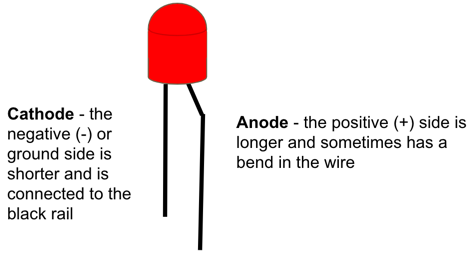


I can suggest a couple of reasons why common anode are favored: Of course with common anode strips you could use fat PMOS devices too. The idea here is to have a few fat NMOS devices sinking many LEDs currents and many weak sources (I/O pins) driving a few LEDs each. In this case it can be best to have more devices in common cathode and fewer on a common anode. Modern CMOS ICs are much more symmetrical (an ATMEGA328 in an Arduino can source or sink 20mA) since they use bigger PMOS than NMOS to balance the fundamental differences, but the convention of common anode is well established.ĮDIT (More info): If on the other hand you're building a matrix, you'll have to have both current source and sink transistors. A 74LS00 is specced to sink 4-8mA, but source only 0.4mA.
#Led anode cathode arduino series
This was particularly true of the TTL logic used in the 74LS series chips (still widely used as interface chips). Older ICs used to be designed exclusively using N transistors for speed reasons, and so were much better at sinking current than sourcing it. Thus the best solution is to connect a common anode to the positive supply and sink current from each LED using NMOS transistors. You need PMOS/PNP transistors to source current (pull up) effectively, but they'll still be weaker at sourcing than an equivalent N-transistor would be at sinking. NMOS / NPN transistors are stronger in general, more common as discrete and are better at sinking current than sourcing. With either common anode or common cathode you'll have one terminal connected directly to a supply for all LEDs and the other side having the dropper resistor and a control transistor per pin (or IC outputs that are transistors on the inside) either sinking or sourcing a current. 470ohm) and you will measure a lower current flow and, of course, your LED look less bright.The reason common anode is more common is because its easier to sink current than to source it. Try to measure voltage on resistor, and voltage on diode: it will be the same. If you have a digital/analog multimeter try to build the first 2 circuit in attachment (use 220ohm as resistor) and measure the current flow: It will be the same. Like Leon Heller say resistor and led are series-connected, both if you connect source/resistor/led/ground or source/led/resistor/ground, so the current flow will be the same. The commercial value of 220ohm would be fine. In a simple case as a 5v power from the resistance value is suitable: (5 - 1.5) V / 0.015A = 233ohm.
#Led anode cathode arduino generator
a battery car) or the generator could be damaged.īecause the LED has a fixed voltage drop of 1.5V (it is a common value, but different LED could have different voltage drop) the resistance value to be used is calculated as as ohm laws tell. The LED might burn if the source can provide a lot of current (i.e. Without a resistance the LED would tend to absorb all of the current that the source (in our case the arduino pin which feeds it) can provide. To work properly a LED needs a current of about 15-20mA (or more if it is a high brightness LED). The role of resistance in a circuit powersource/resistance/LED/ground is essentially limiting the current that flows through the LED.


 0 kommentar(er)
0 kommentar(er)
